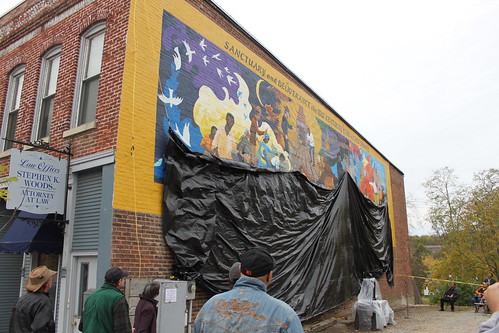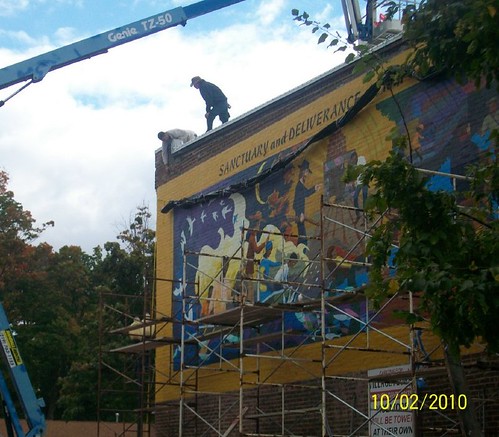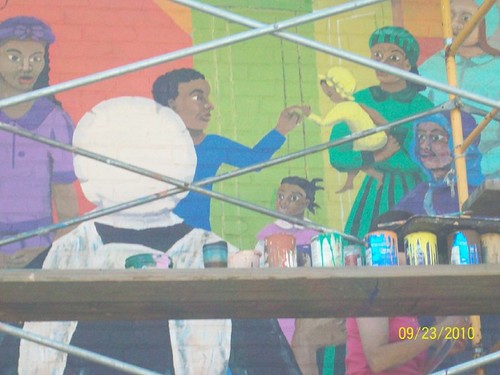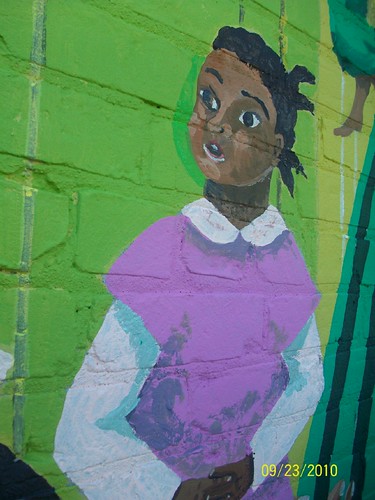A Choice of Nonviolence
Tuesday, November 16, 2010
Sunday, November 7, 2010
Thursday, October 28, 2010
South Bend Tribune Reports on Unveiling Ceremony
By TOM MOOR, Tribune Staff Writer
CASSOPOLIS — More than 150 years later, a group of slaves who risked their lives for freedom by leaving Kentucky for Cass County are being remembered. And they will be for decades to come for anyone traveling through downtown Cassopolis.
A large 25-by-75-foot mural, called Sanctuary and Deliverance, depicting the group of 12 slaves who left Boone and Kenton counties in Kentucky in the spring of 1847, was unveiled Saturday morning in downtown in front of dozens of onlookers.
The event is referred to as the Kentucky Raid and was conjunctive of the Underground Railroad, a network of secret routes that brought slaves in search of freedom from the South to the northern states.
When this group of slaves arrived in Cass County, they were welcomed with open arms by Quakers living there, but their fight wasn't quite over.
Soon after, slave seekers from Kentucky came to Cass County and tried to take them back. After narrowly avoiding a physical conflict, the Kentuckians and the slaves instead went to the Cass County Courthouse, where a judge charged the slave owners with trespassing, kidnapping and assault, and allowed the now-free slaves to stay. Many of them eventually made their way to Canada.
The conflict, like many that were ensuing in the country around the same time, was a piece of the puzzle that would eventually lead to the Civil War and the freedom of all slaves. The important historical moment is a source of local pride.
"It's an important historical event that had national implications," said Deanda Johnson, regional coordinator for the National Underground Railroad. "You guys played a part in the starting of the Civil War."
The mural, which was started in the spring, was worked on by lead artist Ruth Andrews of Cassopolis. A $15,000 grant from the Michigan Humanities Council paid for the project. The Minority Coalition of Cass County also sponsored the event.
Andrews said the colorful mural — which was unveiled halfway through the ceremony as flashbulbs went off — is broken down into four scenes.
The first portrays three generations of slaves crossing the Ohio River at night, escaping the slave owners who had beaten at least one for attending church and threatened to take away their Easter celebration. The second scene shows the slaves settling into a cabin on Quaker land in Cass County, as the Kentucky raiders stormed into the home to challenge the family. One of the drawings is of a slave owner holding one of the slave's young children. "The Kentuckians tried to take them back," Johnson explained.
The third scene shows a mob, a mix of white farmers, Quakers and free blacks, approaching the Kentuckians. "But in Vandalia, they were stopped by a group of 100. It almost got into a physical altercation," Johnson said.
And the final scene is of the Cass County Courthouse, where the slaves were afforded their freedom.
Andrews said it was an honor to work on the mural. "It's been a humbling experience," she said. Johnson said the freedom seekers are "the reason for this history."
The celebration included singing by the Kentucky at Sunrise Community Choir, and a reading by the Cassopolis African American Club. The ceremony ended with a prayer and the singing of "Amazing Grace."
Alisea McLeod, the organizer of the event, said the project has been years on the drawing board, and was kick-started through the grants. "This is a day for celebration," McLeod said. "It's a small, but historically rich community. It will be further enriched by the mural."
Staff writer Tom Moor:
tmoor@sbtinfo.com 574-235-6234
Many Thanks to Our Sponsors!
Sunday, October 24, 2010
Sanctuary and Deliverance Unveiled!
Delivered, Now Free, was read at the opening unveiling ceremony, Saturday, October 23rd:
Delivered, Now Free
By: Ce’ Anderson
Have you heard?
Dey comin’
Dey a comin
Dey comin after me
Is I to be scared?
Why should I fear?
There’s more up here than I’ve ever seen
A Quaker on my side to hide me
Have you seen?
A white man,
Hunting like a spy,
Suspicious as can be,
Telling his men where to capture slaves on land that is free
Have you felt?
A mothers pain,
When they barge in and take her baby away
Did you hear that scream?
Making her come out from hiding,
Childless mother held captive now crying
Have you heard?
I’s not goin back,
They can’t make me,
We fought the fight,
We got the victory,
We kept the faith,
And we is free!
Have you realized?
A raid took place so we can be delivered from slavery,
So we could all live free,
Free from all the suffering,
Free to have integrity
Free to love
Free to breath
Free to live in unity
Free to be proud of Cass County
Monday, October 18, 2010
Parking options for the October 23rd Unveiling ceremony
The Kentucky Raid Mural is located at 150 South Broadway in Cassopolis, MI. There will be NO PARKING on the mural site the day of the Unveiling. There is limited on street parking on both sides of South Broadway.
The Municipal Parking lot is open for parking behind the Southern MI Bank & Trust Building on the corner of Broadway and State Street.
The VFW Post is another option for parking. The VFW Post is the inclement weather site and is located diagonally across from the mural site. Parking is accessible BEHIND the VFW Post by using the one street-South Rowland-(off MI #60). RESTROOMS are also available at the VFW. (Please THANK the VFW for their cooperation and support of this event)!
Additional parking is available open at the United Presbyterian Church located on MI #60 ( 209 E. State Street). This location is approximately 2 ½ blocks from the mural site.
Friday, October 15, 2010
Wednesday, October 13, 2010
Preview
Thursday, September 30, 2010
Unveiling Ceremony Planned!
Sunday, September 26, 2010
An Introduction to the Kentucky Raid into Cass County
In the spring of 1847 during the Easter holiday twelve African Americans from Kenton and Boone Counties freed themselves from the Kentucky farmers who held them in slavery. The African Americans followed a plan that they had put together to secretively leave the farms where they were enslaved and walk twelve miles to Covington, Kentucky. After their twelve-mile walk in darkness, they went down to the river bank, found a boat and rowed themselves across the river to Cincinnati, Ohio.
These freedom-seekers did what most enslaved African Americans had to do to break the chains of slavery. They took the first steps to freedom all by themselves because there was no Underground Railroad on southern soil.
On the free side of the Ohio River in Cincinnati look-outs from black communities near the River usually received freedom-seekers and arranged for their safe transfer to hiding places. The first helpers would then hand the freedom-seekers over to other Underground Railroad agents who could transport them father north.
One African American who came to Cass in 1847 named Perry Sanford remembered that two men met them after they climbed out of the boat. One man was black and the other was white. The men found different places to hide everyone in the group. The whole group of twelve was hidden, rested and fed in Cincinnati for about a week before escorts started with them on the Underground Railroad journey north. The group made it to Cass County in about three weeks and most of them were offered work on Quakers’ farms Penn, Porter, and Calvin Townships.
The raid on Cass County was also well-planned. The Boone and Kenton County slaveholders planned their own conspiracy to kidnap the people who had freed themselves. Months before the raiders came to Cass, they hired a spy to come to Cass to find out where the people they claimed as their “property” were living.
The spy, who called himself “Carpenter,” told everyone he met that he was an abolitionist newspaper reporter. After talking to people in Cass County, “Carpenter” returned to Kentucky and gave the slaveholders the information they needed. When the slaveholders came to Cass, they knew exactly which cabins and which farms to invade thanks to “Carpenter.”
In the courtroom in Detroit, one of the Cass County Quakers recognized “Carpenter” and testified that he had talked to him about “runaways in the area”!
Five years before the Raid, Rev. Charles Osborn moved to Cass where his son, Josiah, and Josiah’s family were living. Rev. Osborn moved to Cass because he was disqualified from serving on an executive committee of the Indiana Yearly Quaker Meeting for refusing to remain silent about the sin of slavery.
After moving to Penn Township, Rev. Osborn organized a new Quaker Meeting named the Young’s Prairie Anti-Slavery Friends. This new Meeting took a strong stand against slavery, and it was this group of Quakers who led the anti-slavery cause in Cass County. They gave assistance to African American freedom-seekers who came to Cass on the Underground Railroad. The Birch Lake Quaker Meeting in Cass disowned their members who joined the Young’s Prairie Anti Slavery Friends Meeting.
Some of the people who helped in Cass County’s Underground Railroad were not Quakers. William Holman Jones and David Thompson Nicholson were both prosecuted by the Kentuckians for helping the freedom-seekers get away, but neither Jones nor Nicholson were Quakers. At least one African American who lived in Vandalia also worked regularly with Zachariah Shugart as an Underground Railroad escort. His name was Henry Shepard.
Although no one was fatally injured during the Raid, there was violence between the Kentuckians and some of the black men inside the cabins. Several black men resisted the invaders and fought back when the raiders tried to seize and shackle them.
But the violence did not spread outside of the cabins. If it had spread, many could have lost their lives. But Josiah Osborn prevented all-out violence. Josiah offered a compromise to the Kentuckians and the crowd of more than 100 blacks and whites from surrounding farms. Josiah appealed to the raiderrs and to the crowd to go to Cassopolis and give the captured people a fair trial Osborn’s appeal defused everyone’s anger, and they all headed for the Cass County Courthouse.
Nine African Americans-- some men and some women--were captured during the Raid, but they were later released. The nine captured and thirty-four others left Cass within a few days of the Raid. That means that a minimum of forty-three African Americans were living in Cass in August 1847. All of them had close connections to the nine people the Kentuckians tried to capture. All forty-three were willing to leave everything in Cass behind and move on. If they were free people, would they have left?
In the Cass County courtroom, the Kentuckians lost their case. When the Kentuckians went home empty-handed, they complained bitterly about the “scoundrels” in Cass who kept them from recovering their “property.” Their complaints went from their local newspapers to the Kentucky legislature to the floor of Congress in Washington. The Raiders’ complaints and others’ added fuel to arguments for a stronger Fugitive Slave Law.
By the time the second trial took place in US Circuit Court in Detroit, there was a new Fugitive Slave Law and the Kentuckians scored a victory against the Cass County abolitionists.
The unsuccessful recapture of human “property” in Cass and Calhoun Counties and in other states inflamed the conflict between the northern and southern states and led, ultimately, to the Civil War.
Researched and written by Dr. Veta Tucker this information is available in its entirety in the publication: A Twenty First Century History of the 1847 Kentucky Raid by Fortitude Graphic Design and Publishing: Kalamazoo, MI 49001, 2010. A black and white copy may be purchased for $5.00 plus $1.50 postage and handling ($2.00 to mail to Canada). Please contact the: Minority Coalition of Cass County, PO Box 413, Cassopolis, MI 49031 for a copy (by sending a check or money order and your complete address and phone number).
Thursday, September 16, 2010
“Can public art make a difference in a community?
Communication – artwork proclaims, in a unique way, who we are to visitors and residents
Focal point in community—matter of pride
Sends message – we can all make a difference
Encourages interplay of diverse and disagreeing opinions – brings diverse views to surface for discussion
Supports discussion between each other
Provides entrepreneurial opportunities – tourism
Creates enduring traditions
Respects culture
Sparks the desire to learn more about local history
Important to know the past going into the future
Impacts all ages and backgrounds
Engage students; they can learn more of the background and add to the painting
Gives youth a positive message about creativity
Serves as an educational tool and experience for parents/families
Serves as a visual aid illustrating the concept that what is normal & accepted now,
may not be in the future
Need for public art -of all kinds- as a positive influence in our daily lives (architecture)
Thursday, August 26, 2010
Excerpts from our National Gallery of Writing contributions
Response: I’ve developed a new definition of creativity. Artists and patrons normally place a high value on
originality, yet, in our project, originality had to take a back seat to seeing through collective eyes. Creativity is now about meeting my aesthetic standards while satisfying the committee and representing the Kentucky Raid in a way the public can appreciate. Without the committee, I wouldn’t have been sensitive enough to avoid certain pitfalls.
Question to artist: What might the Kentucky Raid mural teach the public? What has the experience of creating it taught you so far?
Response: I hope viewers will wonder about and imagine the lives of every character represented. One of my favorite characters is the baby; the baby represents the destruction of families. I think about how the baby’s mother bolted out the window in fear, but her baby’s cry drew her out of hiding and in to captivity. The mother reacted instinctively in both situations – she did not have the leisure of making decisions. We now have the responsibility of creating a society that supports rather than destroys families. What ought we to do? Why aren’t we doing it? In roughly six generations, we have moved from slavery to choosing a black president. Even though we have a long way to go toward racial equity, we are finding our way.
For the complete interview- and others- see our National Gallery of Writing Collection!
Tuesday, August 24, 2010
Monday, August 23, 2010
Forum on Art & Community
Saturday, August 7, 2010
Wednesday, August 4, 2010
Booker T. Washington Visited Cass County, MI
Here are some excerpts from : Two Generations Under Freedom written for The Outlook, February 7, 1903, Mr. Washington's review of the visit cumulated into 12 pages with photos:
“In Calvin Township in 1900 there were 759 negroes and 512 whites. I made diligent inquiry to ascertain if there was any friction between the two races, and could find no evidence that there was.” (page 420).
“I was a little curious to see to what extent the colored people took interest in the large national questions. I asked a good many of them how they stood on the question of reducing the tariff on Cuban sugar. In spite of the fact that Michigan is producing much beet sugar, I found that most of the colored people in this township were in favor of helping Cuba, and they were not slow to give their reasons.” (page 422).
“In my inspection of their church houses there were two things that specifically pleased me. One was the fine and neat appearing parsonage which stood near the Chain Lake Baptist Church; the other was the appearance of the graveyard near the same building. The church house, the parsonage, and the graveyard gave one a picture which made him feel that he was in a Massachusetts village. The graveyard was laid out in family plots, and most of the graves had marble slabs or headstones. There were evidences that the burial-place received systematic care.” (page 423).
Excerpts from: Tales of the Great Lakes: Stories from Illinois, Michigan Minnesota, Wisconsin. Castle, 1986.
Monday, July 5, 2010
Thursday, July 1, 2010
Upcoming Events!
Call for Names: “in search of African Americans who were living in Cass County, MI during the 1847 Kentucky Raid.” Please contact: Veta Tucker at tuckerv@gvsu.edu or at 616-331-3692.
Wednesday, June 16, 2010
Wednesday, June 2, 2010
Tools of the Trade
Monday, May 10, 2010
Volunteers Work Preparing Wall
Details of the Journey

One section of the mural will depict Joseph Sanford of Boone County, Kentucky. Dr. Veta Tucker, Professor of English and Africian American Studies and Chair of the Michigan Freedom Trail Commission , writes of Joseph Sanford's experience:
"On Easter Sunday in 1847 when everything on the farm was quiet, Joseph Sanford and some of his friends left John Graves' farm in Boone County, Kentucky hoping never to come back. Joseph's wife and son and some of the others who left with Joseph that night lived on John Graves' brother's farm in nearby Kenton County. To avoid walking down the open roads, the freedom-seekers walked through the dark woods. It took them longer than usual to walk the twelve miles to Covington, Kentucky, but they made it before daylight. When they went down to the riverbank, there was no one there to row them across the Ohio River. They spotted a skiff, and all thirteen of them climbed in. The skiff was so overloaded that the water almost poured in the sides, but by sitting very still, they rowed across the river to the Ohio shore just as the sun came up. Joseph was very afraid that he would cross the path of someone who had seen him in Cincinnati before because he had driven his 'master's' wagon many times to Cincinnati to sell farm produce. Instead of familiar faces, however, the freedom-seekers met strangers they had never seen before. The strangers were slave-catchers who pretended to help Joseph Sanford and the others find a safe place to hide."
Monday, April 26, 2010
National Gallery of Writing

The Minority Coalition of Cass County, organizers of the "Sanctuary and Deliverance" mural project, would like to invite persons interested in the operation of the Underground Railroad in Cass County to submit papers to the group's online collection of stories and responses. All submissions are welcome.
Tuesday, March 16, 2010
Project Goals--brick by brick

Our Sanctuary and Deliverance Project wants to re-affirm lessons from our Southwest Michigan past.
The goals are to readily communicate these values via public art:
-create a work of art that instills pride and solidarity in the residents of Cass County
-accurately depict and write the history of the Kentucky Raid by writing a pamphlet and discussion guide and designing portable banners that supplement and elaborate on the depictions in the mural
-engage local residents of Cass County and visitors in discussions of the ethical choices the people of Cass County faced during the Kentucky Raid and the relevance of those choices today
-provide forums for discussion and writing about the Kentucky Raid and related topics that capture a diversity of voices
-inspire local Cass County residents and visitors to adopt the values of social justice, compassion and cooperation
The Michigan Humanities Council in Lansing, MI approved Sanctuary and Deliverance mural project as a catalyst for social change and a way to positively connect with local history. The Cassopolis Vigilant (on 2-18-2010) quoted our scholar, Veta Tucker, as saying: “There was a special community here in Cass County, a community where free African Americans worked their own land, established their own churches, started businesses, and enjoyed some of the same rights their white neighbors enjoyed. We need to celebrate this history.”
Join us in the process! As lead artist, Ruth Andrews, scales the wall, envision each brick as a connection to the past as well as a bridge to the present. Help us re-build our community in an honorable venue and consider volunteering!
“This project is funded in part by the Michigan Humanities Council, an affiliate of the National Endowment for the Humanities. Any views, findings, conclusions, or recommendations expressed in this project do not necessarily represent those of the National Endowment for the Humanities.”
Friday, March 12, 2010
Black History Breakfast Features Sonya Hollins
 The featured speaker for the Minority Coalition's
The featured speaker for the Minority Coalition'sAnnual Black History breakfast was Sonya Bernard-Hollins, author of Here I Stand, a Musical History of African Americans in Battle Creek, Michigan.
Hollins, co-owner of Fortitude Graphic Design of Kalamazoo with her husband Sean Hollins, spoke of
the rich history of African American ingenuity in southwest Michigan. A strong promoter of self-publishing, Sonya Hollins is collaborating with Dr. Veta Tucker and Dr. Alisea Williams McLeod on a publication focused on the Kentucky Raid of 1847, a critical event in the history of the Underground Railroad in Cass County, Michigan. Dr. Tucker also spoke at the breakfast. She expressed the importance of continually rewriting history as new information becomes available. This summer the Minority Coalition plans to install in Downtown Cassopolis a mural depicting the Raid.













